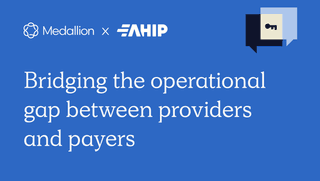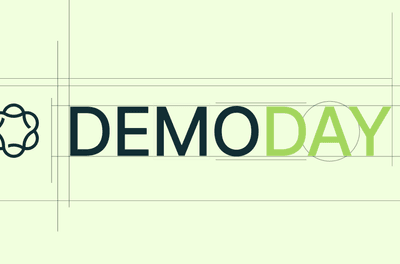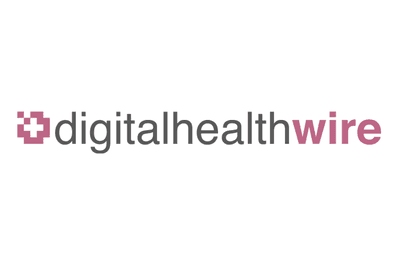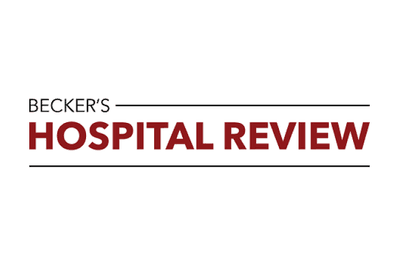How to bridge the operational gap between providers and payers
It’s no secret that the relationship between providers and payers is often seen as an adversarial one. But as technology and the healthcare industry evolve, maybe it’s time to evolve this relationship and the operational workflows that come with it as well.
As the healthcare industry rapidly becomes more consumer-like, fueled by patient expectations, payers are pressed to find ways to effectively and efficiently grow and maintain their provider networks, manage staffing shortages, and shift to value-based care models while remaining in compliance with regulatory bodies.
Based on Merritt Hawkins’ 2019 Physician Inpatient/Outpatient Revenue survey highlighting that a one-day delay in provider onboarding can cost a medical group more than $10,000, Medallion’s Senior Director of Credentialing, Caitie Barrett, sat down with Matthew Ortiz, the Vice President of Payor Strategy and Relations at Family Care Center, a growing outpatient behavioral health provider headquartered in Denver, Colorado, to discuss how payers can deliver a more meaningful member experience by better bridging the gap between payers and provider operations.
Matthew has been working in the healthcare space for over 10 years, spending time on both the payer and provider side.
Matthew began his career in the senior living space focusing mainly on the Medicare Advantage population, and then transitioned over to the payor side while managing plans that targeted the Medicaid population of individuals with intellectual and developmental disabilities.
He later transitioned back over to the provider side in the behavioral health space and has since worked with autism and mental health-related service providers.
Being able to serve in different payor-facing roles at both ends of the spectrum has given Matthew a unique perspective on the payer/provider relationship and how they can work together to reduce barriers and provide access to care.
The conversation is below. If you're short on time, here are a few quick takeaways:
- Collaboration across both payers and providers is paramount to achieving operational workflow excellence and delivering on quality patient care.
- Automation and technology innovation can elevate operational workflows, often doing the heavy lifting and removing administrative burdens which enable teams to elevate their roles and responsibilities.
- Keeping communication lines open is critical for forming more informed, closer payer-provider relationships.
A lightly edited transcript of the webinar with Matthew follows. The conversation has been transcribed and edited to the best of our abilities and please allow for a slight margin of human and machine error.
Caitie Barrett: Hi, Matthew, and welcome.
Matthew Ortiz: Hi, Caitie. Thank you for having me today. It's a pleasure to be part of the webinar and conversation.
Caitie: You've worked across so many different organizations. Could you give us your perspective on some of the major things you've seen shifting in healthcare at this point?
Matthew: Sure. There are a few things. Many people are probably tired of talking about COVID and its impact, but that's the reality of the world we live in right now. It's brought a ton of different changes.
The number one thing is that its impacted many different services and the provision of telehealth.
That's been a significant shift, and it started happening before [COVID], but essentially consumers have changed how they prefer to receive non-emergent healthcare services.
Many folks would prefer doing those things from the comfort of their homes instead of sitting in a provider's office, depending on the type of service they're trying to get.
The labor market has also impacted networks of payers and being able to have adequate networks and access to care. The "phantom network" is a term thrown around recently. Suppose you go on websites or look at the directories, [phantom networks mean] having a long list of payers and providers in their network. However, those networks might not employ actual clinicians and providers to provide those services.
Additionally, folks are strapped for talent. There's a huge lack of quality clinicians in many areas, whether you're talking about long-term services, support, nurses, or behavioral health.
Another big challenge that has been developing over the last ten years is [the shift to] value-based care and trying to manage it. That's been a huge change in healthcare where payers have to hold providers accountable for outcome-based measures, and [it's a challenge] ensuring you're capturing all of that data.
Those are the main things I've seen change and shift when managing networks and provider groups.
Credentialing is more than an admin function
Caitie Barrett: With that, the administrative pieces and the burnout leading to the lack of providers who provide care, is that something you're seeing in your [own] work?
Matthew Ortiz: Absolutely. Credentialing is one of the biggest barriers. We see providers get hired to provider groups, and they're sitting around waiting for payers to get them credentialed before they can provide billable services. That puts a huge monkey wrench into things.
I've been with organizations where you've seen providers frustrated and leave because they couldn't provide the services the provider groups hired them to provide. So that's a huge cog in the wheel that we can both work towards trying to resolve.
Caitie: It's tough because credentialing is not just an administrative task that has to be done. It's important to make sure folks are who they say they are. Or they have the credentials that they say they have. Trying to balance all of those pieces, from filling out multiple forms to providing quality care, is tough. Have you seen shifts in the payer-provider relationship regarding how folks work together?
Matthew: Many payers are in tune with the credentialing struggles that exist out there. We're starting to see some movement, whether making that process simpler or I've witnessed payers working more off of a roster-type submission. For instance, payers are digging in on their end and utilizing CAQH to help credential providers rather than submitting several applications and filling out a ton of paperwork.
Delegated credentialing is a huge opportunity for a lot of provider groups. It's something that I've had some very recent experience and success in where providers are taking the onus upon themselves of parenting their clinicians. The important thing here is ensuring you've got everything in place to do it.
[To your point, credentialing] is not just an administrative function. It's ensuring that you're hiring quality clinicians that can provide the services they are licensed to offer and that they don't have negative hits against them. From past experiences, you want to ensure that you vet the folks.
We're getting to a spot where there's more collaboration between payers and provider groups, and with that, you can work through issues quickly. That's super important, just being able to find things that come up and address concerns much quicker and getting those providers through the pipeline so that we can provide services to our patients and payers to their members.
Communication is the key to change
Caitie Barrett: Have there been times when you've experienced top-notch collaboration that enabled you to work more seamlessly together?
Matthew Ortiz: Absolutely. The foundational aspect is that there are well-run provider relations teams. Organizations call it different things: provider solutions, advocates, and relations. Whatever the term, they're an individual organization. When you've got an outstanding team on the payer side, one that's going to be collaborative and quick to respond and handle your issues and provide resources and things of that nature, it makes it much easier for provider groups to provide their services.
We all aim to provide quality care, improve people, and deal with health care concerns. It's important to be collaborative and work together.
Caitie: Are there particular resources you've received before that have been super helpful?
Matthew: Yes, the provider manual is very helpful. Whether it's a quick reference guide or clearly outlined information providers need from payers, that's the most important thing. On the reimbursement side or the authorization side, there are times when you have to dig to find a requirement or something that is causing a disruption. When that stuff is clearly outlined and made available to providers, it makes everyone's lives easier.
Another helpful thing I've seen is where payers have held continuing education seminars [where they share] the changes that are going on with health plans.
I've seen that more on the managed Medicaid side than I have on the commercial side, but things flow more efficiently when all those opportunities exist.
It's all about communication, like any relationship. That's the most important element.
Caitie: Yes. Medallion is an NCQA-Certified CVO, so the NCQA is often the group we look to for those kinds of updates. Let's zoom out to managing a large group of providers. We've talked about making it easy for them to get in-network, but are other things that have changed or become more important?
Matthew: I know we've talked a lot about collaboration. That's a huge thing. Payers being able to reduce barriers to allow providers to grow quickly and provide services on a timely basis is super important, whether it's eliminating credentialing barriers or reimbursement barriers, or things that are tedious throughout the processes.
It's also a two-way street. Full ownership should fall to more than just the payer side. Providers must also be willing to follow payer procedures to avoid network disruption.
The constant communication and collaboration between network management and provide relations teams with provider groups can't be understated.
An understanding (on both sides) enables better workflows
Caitie Barrett: Totally. I'd like to hear about how you've seen success in building out operational workflows within your role on the provider side. I know you manage a lot in your day-to-day that requires a lot of different workflows.
Matthew Ortiz: Sure. Clear guidelines from the payer side help. For providers, ensuring that you're following processes and not deviating is key. If new requirements are needed, ensure you're timely adopting those and, again, go back to the collaboration.
Change has always been the number one constant in healthcare. Work groups are a huge opportunity and something I have seen be successful. Whether those help network at large or we work directly with a provider relations team to put regular meetings on the books to talk through things, that hones into outlining clear operational perspectives for both sides.
Payers and providers can learn from each other. Finding out what works and what doesn't work from both sides helps the provider groups tighten up some loose ends. When payers understand what provider groups are struggling with, they can streamline those things and tighten up issues on their end, which can help.
Caitie: You said change is the only constant that exists. We typically know that change is coming, or you're aware of a promise that some change is coming. However, when it happens, sometimes I feel caught off guard by whatever the new thing is because working it into your existing workflow can be difficult. Are there scenarios where you've seen organizations use good communication and collaboration [tactics] to manage change well?
Matthew: Yes, [I've seen it work well] if a change happens, it's communicated months in advance, and reminders have gone out to the network. Communication in various forms, including email blasts, mail, fax, or provider relations teams, are reaching out directly to their networks.
Hitting things from multiple fronts is important. But in addition, it's making sure systems are ready for changes is important.
It's about ensuring communication with provider networks and that everyone within the plan understands [the change].
Overall, payers do a great job of making sure that things go well. The one-offs throw networks into a tizzy and make providers lose confidence in that payer-provider relationship.
Communication eliminates confusion
Caitie Barrett: You've worked on both the provider and payer side. Have you seen any differences in what it takes to build out two different environments?
Matthew Ortiz: Successful operational workflows happen when multiple stakeholders are involved in the process. Including people from operations, finance, provider relations, payers, customer service, and more, keep everyone aware of changes.
It's the same on the provider side. For example, when we're rolling out a service, we make sure providers and clinicians are aware of it–especially if it's something we're adding to our contract or a completely new service.
Where confusion hits home the most is when a member is confused. Whether it's confusion about the type of care they thought they were receiving or a provider they thought was in-network.
Trying to avoid confusion and disruption for the individual receiving the services is the end goal for payers and providers. We want it to be successful.
Caitie: That is so important. Another big area that's been changing in healthcare is the amount of technology and innovation and the different things you can do to enhance or make changes within your workflows. Have you seen innovation impact how you're building out the work you're doing?
Matthew: Yes, the major challenge from innovation is keeping the quality and level of care consistent. Innovation has impacted telehealth networks, for example, and most recently, the provision of telemedicine. There are now provider organizations that exist that are solely telehealth providers. There are no brick-and-mortar buildings to receive care from for some of these provider groups. So how does quality come into play there?
Whether you're a payer or the provider providing services, it's important to ask if innovation and technology will enable you to provide quality care.
The duties are on the provider group and payer organization to ensure the quality of care doesn't decline as technology continues to impact health care [or how you communicate with the individual receiving treatment.] Ensuring quality [of care] should stay at the top of the list for both sides of that relationship.
Automation elevates internal functions
Caitie: Have you seen measures that ensure quality care?
Matthew: Yes, I've worked for companies, especially during the Pandemic, where we were providing services in person, but we were also providing a lot of services via telehealth.
When many of those changes started happening, payers did an excellent job of eliminating barriers and relaxing some claims controls that previously used to be in place, allowing for smooth, streamlined telehealth service provision.
Value-based care is really important and has grown. Whether you are strictly operating on a value-based agreement or starting to track the quality outcomes that can prove that the virtual services you're providing are as important and well functioning as those conducted in person, organizations can do it well.
It's something that everyone has to stay on top of and communicate [throughout].
Caitie: Yes, when you start moving faster and are more efficient, in some ways, it becomes almost more important to show your work, or how things are going, and prove that you are doing something as if it happened in an office visit, in the same way.
In credentialing, we spend a lot of time thinking about how we might be able to move things faster, what that looks like, what we can automate, and what we can get moving through the system in a way that is the fastest thing possible. Finding that balance between speed and a human person reaching out to a provider to give some assistance on something or help them out with something is even more effective than fully leaning in. I think about that balance between tech and real people often.
Matthew: Definitely. I can't speak as much about automation from the payer side, but I have had some experience with that on the provider side. It can make things easier, less administrative, and increase more time spent on value-added activities.
In the last organization I worked for, we had digital workers, or robots, whatever you want to call them, for some of our eligibility and claims billing procedures.
It cut down a considerable amount of administrative time for our team members, and they could in turn, focus on value-added activities that further benefited the organization.
Caitie: Right. Automation often isn't about removing a whole workflow. It's about taking the things that are consistent and removing them so humans can work on more interesting things, focus on providing a higher level of care, and streamline.
Matthew: I agree 100%.
Technology leads to ‘big picture’ thinking
Caitie Barrett: The other piece we think about a lot about innovation around technology is using data in bigger ways. Is that something that has impacted the work that you're doing?
Matthew Ortiz: Yes. Tracking outcomes and collecting data helps with providing quality care and ensuring that we stay on top of those different data elements. It relates to operations because if you're operating ineffectively, those outcomes will not be as positive as we want them to be.
There's also an unlimited amount of data we have now that technology is so ingrained in everything we do.
The ability to track claims data or understand how long it's taken to get a provider credentialed within the last six months helps you make better decisions as an organization.
If you notice negative trends in some areas, you know that's where you should focus. [Data innovation and technology] can help you be a better organization.
It's also important to dedicate resources to [innovation and technology]. The more technology advances, the easier it is to [track claims data and provide quality care] and those types of things.
Caitie: That makes sense. On the data piece, has that impacted the work that you did on the payer side?
Matthew: Yes. I was on the network management side of things, and we collected a ton of data about our network. We paid a lot of attention to geo access to ensure we had enough providers in every area of the region that we were managing. It was important to ensure that we were recruiting new providers in that area and making sure that we were helping our current existing providers to grow in those areas.
Drive better patient care through collaboration
Caitie Barrett: Great. Let's shift the conversation a bit. What leads to a positive relationship and workflow experience for payers and providers?
Matthew Ortiz: It goes back to communication and collaboration. I'll continue to hit on that point.
If both sides are aligned, it will result in a positive patient experience. Both sides can also ensure members are aware of changes and updates.
I have been in situations where a large change impacted enrollees of the plan, so they needed to know what was going on. The payers did a great job ensuring their members were up to speed.
Or, on the provider side, if their network changes, that's 100% something that individual members should be aware of.
Making sure that that third party is included as payers and providers are thinking through those operational workflows is paramount to the success of driving quality and care.
Caitie: Is something that you've seen done well?
Matthew: I have. It happens when you send out continual communication or where front-line providers have those discussions with members as they're coming in for services, especially if it's a service where they have regular appointments.
In my behavioral health world, where folks are coming in for continual sessions, having that personal connection speaks volumes.
We're not all machines here. Healthcare is made up of human beings doing all these different things. Adding the human connection is very successful.
For a member to feel like their health plan is not just the name on their card; there are people they can reach out to for member support is super important. It's interconnected and paramount and helps ensure they feel included and cared about in all situations and decisions.
Caitie: The relationship piece certainly plays out there. All of the inputs we've talked about today come through that moment of being able to inform people accurately. Thank you, Matthew, for taking the time to answer my questions.
Matthew: Absolutely. Thanks again for giving me the opportunity. Great conversation. We can all learn from this, and I look forward to seeing where it goes.
Caitie: Thank you.



